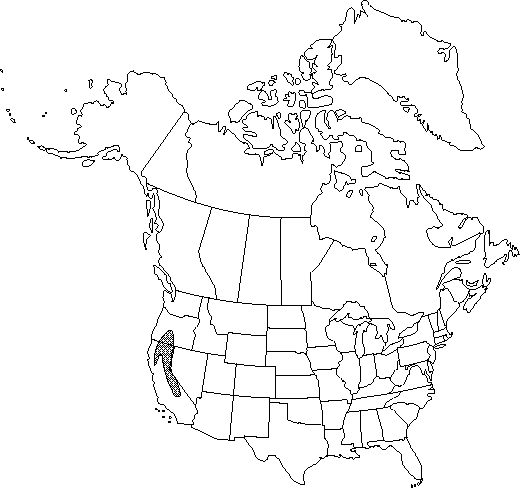familyRanunculaceae
genusRanunculus
subgenusRanunculus subg. Ranunculus
sectionRanunculus sect. Ranunculus
speciesRanunculus occidentalis
Difference between revisions of "Ranunculus occidentalis var. ultramontanus"
Pittonia 3: 13. 1896.
Endemic
Treatment appears in FNA Volume 3.
FNA>Volume Importer |
FNA>Volume Importer |
||
| Line 20: | Line 20: | ||
}}<!-- | }}<!-- | ||
| − | --><span class="statement" id="st- | + | --><span class="statement" id="st-undefined" data-properties=""><b>Stems </b>± reclining, 1-3 mm thick, hirsute or sometimes glabrous. <b>Basal</b> leaf blades 3-foliolate, rarely merely 3-parted, ultimate segments oblong or elliptic to lanceolate or oblanceolate, margins dentate or dentate-lobulate. <b>Flowers</b>: sepals 5, 4-6 mm; petals 5-6, 6-8 × 1.5-2.5 mm. <b>Achenes</b> 3-3.4 × 2-2.6 mm, glabrous, rarely hispid; beak lanceolate, curved, 0.4-1.2 mm.</span><!-- |
-->{{Treatment/Body | -->{{Treatment/Body | ||
| Line 51: | Line 51: | ||
|publication year=1896 | |publication year=1896 | ||
|special status=Endemic | |special status=Endemic | ||
| − | |source xml=https://jpend@bitbucket.org/aafc-mbb/fna- | + | |source xml=https://jpend@bitbucket.org/aafc-mbb/fna-data-curation.git/src/9216fc802291cd3df363fd52122300479582ede7/coarse_grained_fna_xml/V3/V3_489.xml |
|genus=Ranunculus | |genus=Ranunculus | ||
|subgenus=Ranunculus subg. Ranunculus | |subgenus=Ranunculus subg. Ranunculus | ||
| Line 57: | Line 57: | ||
|species=Ranunculus occidentalis | |species=Ranunculus occidentalis | ||
|variety=Ranunculus occidentalis var. ultramontanus | |variety=Ranunculus occidentalis var. ultramontanus | ||
| − | |||
| − | |||
| − | |||
| − | |||
| − | |||
| − | |||
| − | |||
| − | |||
| − | |||
| − | |||
| − | |||
| − | |||
| − | |||
| − | |||
| − | |||
| − | |||
| − | |||
| − | |||
}}<!-- | }}<!-- | ||
-->[[Category:Treatment]][[Category:Ranunculus occidentalis]] | -->[[Category:Treatment]][[Category:Ranunculus occidentalis]] | ||
Revision as of 13:42, 27 July 2019
Stems ± reclining, 1-3 mm thick, hirsute or sometimes glabrous. Basal leaf blades 3-foliolate, rarely merely 3-parted, ultimate segments oblong or elliptic to lanceolate or oblanceolate, margins dentate or dentate-lobulate. Flowers: sepals 5, 4-6 mm; petals 5-6, 6-8 × 1.5-2.5 mm. Achenes 3-3.4 × 2-2.6 mm, glabrous, rarely hispid; beak lanceolate, curved, 0.4-1.2 mm.
Phenology: Flowering spring–summer (May–Jul).
Habitat: Meadows
Elevation: 1300-2100 m
Distribution

Calif., Nev., Oreg.
Discussion
Ranunculus occidentalis var. ultramontanus is found at middle elevations in the Sierra Nevada, southern Cascades, and northeastern Coast Ranges. It intergrades with var. occidentalis in the region of elevational overlap.
Selected References
None.
Lower Taxa
None.